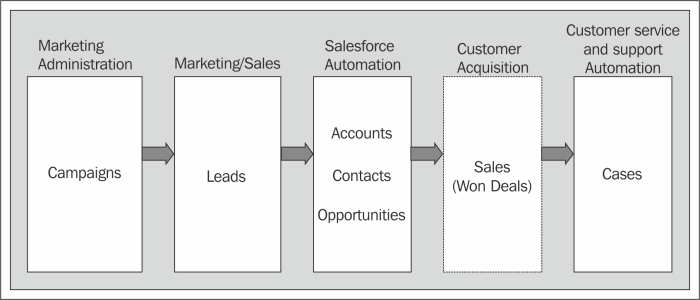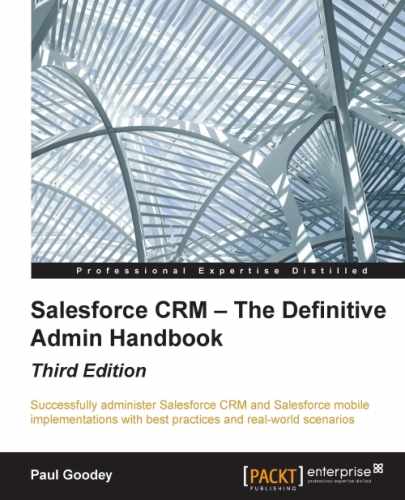This chapter gives you an overview of the functional areas within Salesforce CRM, where we will look at the process from the campaign to the customer and beyond. Within the functional areas, there are various touch points where the business teams concerned with marketing, sales, and customer service have to agree on roles and responsibilities for aspects of the business processes. We will now look at each of the following core Salesforce CRM functions:
- Marketing administration
- Sales automation
- Customer service and support automation
- Enterprise social networking and collaboration with Salesforce Chatter
The Salesforce CRM functions are related to each other and, as mentioned previously, have crossover areas that can be represented as shown in the following diagram:

Marketing administration is available in Salesforce CRM under the application suite known as the Marketing Cloud.
The core functionality enables organizations to manage marketing campaigns from initiation to lead development in conjunction with the sales team. The features in the marketing suite can help measure the effectiveness of each campaign by analyzing the leads and opportunities generated as a result of specific marketing activities.
Salesforce automation is the core feature set within Salesforce CRM and is used to manage the sales process and activities. It enables salespeople to automate manual and repetitive tasks and provides them with information related to existing and prospective customers. In Salesforce CRM, Salesforce automation is known as the Sales Cloud and helps salespeople manage sales activities, leads and contact records, opportunities, quotes, and forecasts.
Customer service and support automation within Salesforce CRM is known as the Service Cloud and allows support teams to automate and manage requests for service and support by existing customers. Using the Service Cloud features, organizations can handle customer requests such as the return of faulty goods or repairs, complaints, or provide advice about products and services.
Associated with the functional areas, described previously, are features and mechanisms that help users and customers collaborate and share information, this is known as enterprise social networking.
Enterprise social network capabilities within Salesforce CRM enable organizations to connect with people and securely share business information in real time. Social networking within an enterprise serves to connect both employees and customers and enables business collaboration. In Salesforce CRM, the enterprise social network suite is known as Salesforce Chatter.
The capabilities of Salesforce CRM provide for the processing of campaigns through to customer acquisition and beyond, as shown in the following diagram:

At the start of the process, it is the responsibility of the marketing team to develop suitable campaigns in order to generate leads. Campaign management is carried out using the Marketing Administration tools and has links to the lead and also any opportunities that have been influenced by the campaign.
When validated, leads are converted to accounts, contacts, and opportunities. This can be the responsibility of either the marketing or sales teams and requires that a suitable sales process to have been agreed upon. In Salesforce CRM, an account is the company or organization and a contact is an individual associated with an account.
Opportunities can either be generated from lead conversion or can be entered directly by the sales team. As described earlier in this book, the structure of Salesforce requires account ownership should be established; this looks at inherited ownership of the opportunity. Account ownership is usually the responsibility of the sales team.
Opportunities in a CRM system are usually processed using an agreed sales process with predefined sales stages. Sales stages typically advance to a final stage of either closed/lost or closed/won, where a closed/won opportunity represents a successful sale. Successful sales opportunity information should then be logged in the organization's financial system.
Upon acceptance of the deal by the finance team (and perhaps the delivery of the goods or service), the post-customer acquisition process is then enabled where the account and contact can be recognized as a customer. Here, the customer relationships concerning incidents and requests are managed by escalating cases within the customer services and support automation suite.
